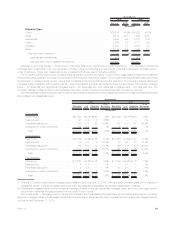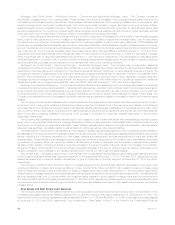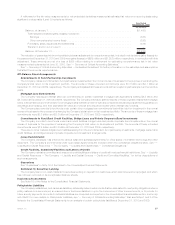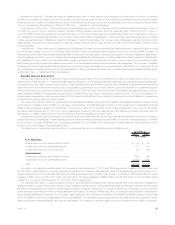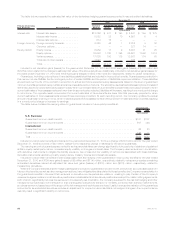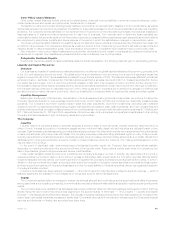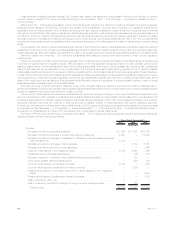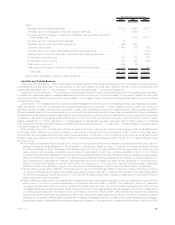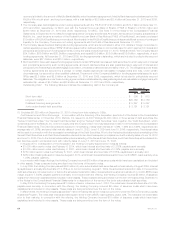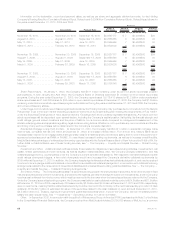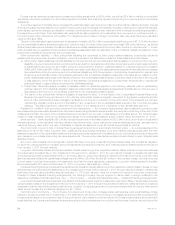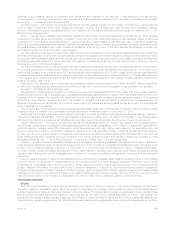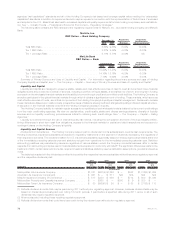MetLife 2010 Annual Report Download - page 66
Download and view the complete annual report
Please find page 66 of the 2010 MetLife annual report below. You can navigate through the pages in the report by either clicking on the pages listed below, or by using the keyword search tool below to find specific information within the annual report.
2010 2009 2008
Years Ended December 31,
(In millions)
Uses:
Netcashusedininvestingactivities................................ 18,314 13,935 2,671
Netcashusedforchangesinpolicyholderaccountbalances ............... — 2,282 —
Net cash used for changes in payables for collateral under securities loaned and
othertransactions.......................................... — 6,863 13,077
Netcashusedforchangesinbankdeposits .......................... 32 — —
Netcashusedforshort-termdebtrepayments......................... 606 1,747 —
Long-termdebtrepaid ........................................ 1,061 555 422
Netcashpaidinconnectionwithcollateralfinancingarrangements............ — — 800
Treasury stock acquired in connection with share repurchase agreements . . . . . . . — — 1,250
Dividendsonpreferredstock .................................... 122 122 125
Dividendsoncommonstock .................................... 784 610 592
Cashusedinother,net........................................ 299 34 —
Cash used in the effect of change in foreign currency exchange rates . . . . . . . . . . 129 — 349
Totaluses ............................................... 21,347 26,148 19,286
Net increase (decrease) in cash and cash equivalents . . . . . . . . . . . . . . . . . . . . . $ 2,934 $(14,127) $13,871
Liquidity and Capital Sources
Cash Flows from Operations. The Company’s principal cash inflows from its insurance activities come from insurance premiums, annuity
considerations and deposit funds. A primary liquidity concern with respect to these cash inflows is the risk of early contractholder and
policyholder withdrawal. See “— The Company — Liquidity and Capital Uses — Contractual Obligations.”
Cash Flows from Investments. The Company’s principal cash inflows from its investment activities come from repayments of principal,
proceeds from maturities, sales of invested assets and net investment income. The primary liquidity concerns with respect to these cash
inflows are the risk of default by debtors and market volatility. The Company closely monitors and manages these risks through its credit risk
management process.
Liquid Assets. An integral part of the Company’s liquidity management is the amount of liquid assets it holds. Liquid assets include cash,
cash equivalents, short-term investments and publicly-traded securities, excluding: (i) cash collateral received under the Company’s
securities lending program that has been reinvested in cash, cash equivalents, short-term investments and publicly-traded securities;
(ii) cash collateral received from counterparties in connection with derivative instruments; (iii) cash, cash equivalents, short-term investments
and securities on deposit with regulatory agencies; and (iv) securities held in trust in support of collateral financing arrangements and pledged
in support of debt and funding agreements. At December 31, 2010 and 2009, the Company had $245.7 billion and $158.4 billion in liquid
assets, respectively. For further discussion of invested assets on deposit with regulatory agencies, held in trust in support of collateral
financing arrangements and pledged in support of debt and funding agreements, see “— Investments — Invested Assets on Deposit, Held in
Trust and Pledged as Collateral.”
Global Funding Sources. Liquidity is provided by a variety of short-term instruments, including funding agreements, credit facilities and
commercial paper. Capital is provided by a variety of instruments, including short-term and long-term debt, preferred securities, junior
subordinated debt securities and equity and equity-linked securities. The diversity of the Company’s funding sources enhances funding
flexibility, limits dependence on any one market or source of funds and generally lowers the cost of funds. The Company’s global funding
sources include:
• The Holding Company and MetLife Funding, Inc. (“MetLife Funding”) each have commercial paper programs supported by $4.0 billion in
general corporate credit facilities (see “— The Company — Liquidity and Capital Sources — Credit and Committed Facilities”). MetLife
Funding, a subsidiary of MLIC, serves as a centralized finance unit for the Company. MetLife Funding raises cash from its commercial
paper program and uses the proceeds to extend loans, through MetLife Credit Corp., another subsidiary of MLIC, to the Holding
Company, MLIC and other affiliates in order to enhance the financial flexibility and liquidity of these companies. Outstanding balances for
the commercial paper program fluctuate in line with changes to affiliates’ financing arrangements. Pursuant to a support agreement,
MLIC has agreed to cause MetLife Funding to have a tangible net worth of at least one dollar. At both December 31, 2010 and 2009,
MetLife Funding had a tangible net worth of $12 million. At December 31, 2010 and 2009, MetLife Funding had total outstanding
liabilities for its commercial paper program, including accrued interest payable, of $102 million and $319 million, respectively.
• MetLife Bank is a depository institution that is approved to use the Federal Reserve Bank of New York Discount Window borrowing
privileges. To utilize these privileges, MetLife Bank has pledged qualifying loans and investment securities to the Federal Reserve Bank
of New York as collateral. At both December 31, 2010 and 2009, MetLife Bank had no liability for advances from the Federal Reserve
Bank of New York under this facility.
• MetLife Bank has a cash need to fund residential mortgage loans that it originates and generally holds for a relatively short period before
selling them to one of the government-sponsored enterprises such as FNMA or FHLMC. The outstanding volume of residential
mortgage originations varies from month to month and is cyclical within a month. To meet the variable funding requirements from this
mortgage activity, as well as to increase overall liquidity from time to time, MetLife Bank takes advantage of short-term collateralized
borrowing opportunities with the Federal Home Loan Bank of New York (“FHLB of NY”). MetLife Bank has entered into advances
agreements with the FHLB of NY whereby MetLife Bank has received cash advances and under which the FHLB of NY has been granted
a blanket lien on certain of MetLife Bank’s residential mortgages, mortgage loans held-for-sale, commercial mortgages and mortgage-
backed securities to collateralize MetLife Bank’s repayment obligations. Upon any event of default by MetLife Bank, the FHLB of NY’s
63MetLife, Inc.


